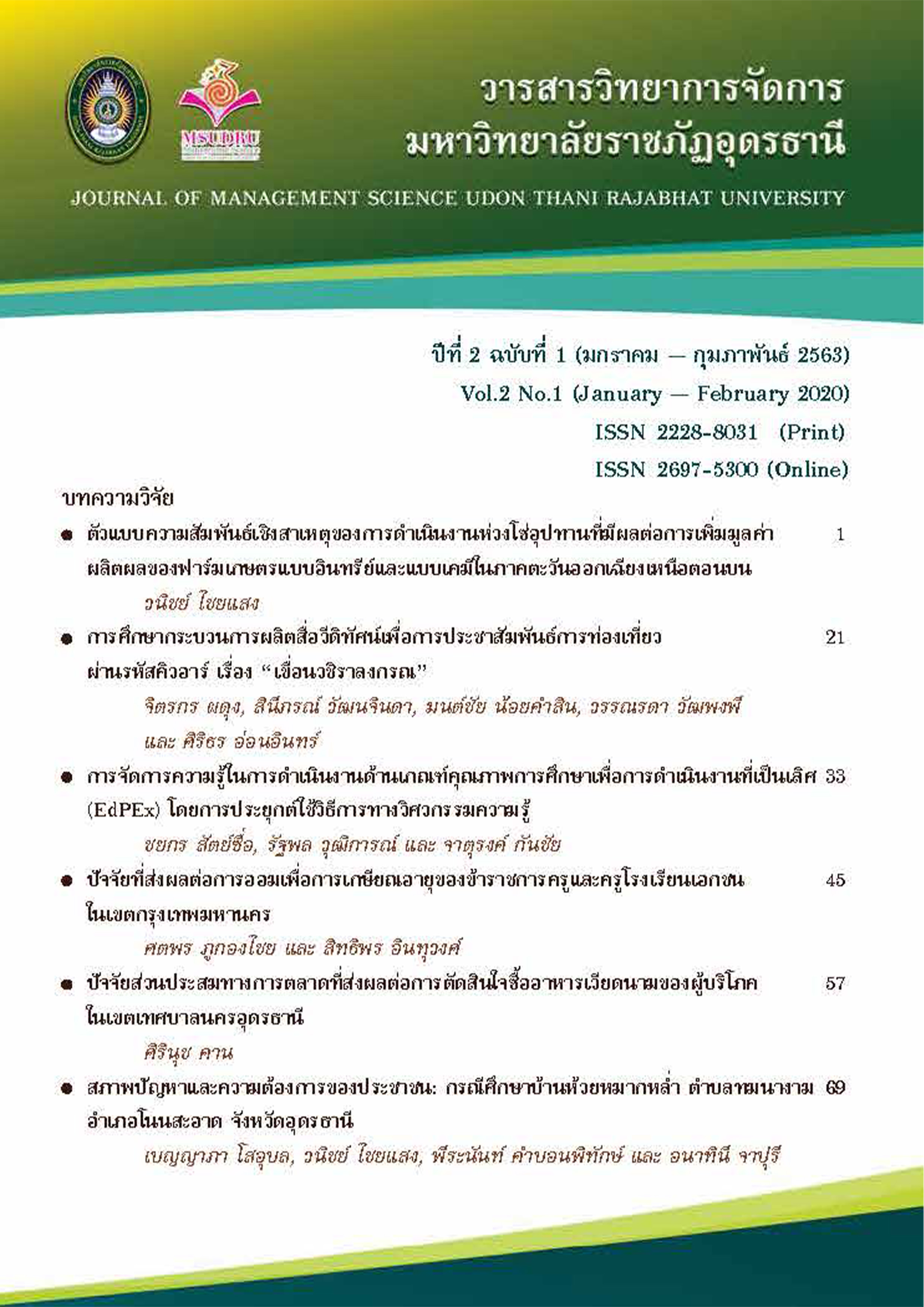CAUSAL RELATIONSHIP MODEL OF SUPPLY CHAIN OPERATION TOWARDS VALUE ADDED PRODUCTIVITY ON ORGANIC AND CHEMICAL FARMING ON NORTH EASTERN REGION
Main Article Content
Abstract
This research aimed to 1) study the components of Supply Chain Operation and Value Added Productivity on Organic and Chemical Farming and 2) study the causal relationship model of supply chain operations affecting value-added products in agricultural farms. The target population from the area of growing vegetables and fruits in the North Eastern Region including Udon Thani, Nong Khai, Bueng Kan and Nong Bua Lam Phu. By stratified sampling and selecting specific target samples by purposive from 111 sample from agricultural farms. Using the questionnaire, the statistics used inferential statistics by path analysis. By using the LISREL program with parameter estimation methods and testing the hypothesis of the function by The Maximum Likelihood Fitting Function. The result revealed that 1) The components of supply chain operations activities of farmers on organic and chemical farming by focusing on the activities of arrangement of planting area for cultivation. The Middle stream activities of both farmers focus on selection of grades and cutting production. Activities to create value added productivity of farmers in organic farms that focus on having quality system and standard for agricultural products but Non-toxic farmers focus on distribution center and transportation management. 2) A causal relationship of agricultural farms in the North Eastern the results showed that the hypothesis 2: the Middle stream activities had a positive influence on value added productivity. By accepting hypothesis that statistical significance at the level of 0.05, and confidence value (R2) is 0.60 especially. The Middle stream activity will directly affect that having a database of information systems to link logistics and having a network of people who involved in the supply chain.
Article Details

This work is licensed under a Creative Commons Attribution-NonCommercial-NoDerivatives 4.0 International License.
บทความที่ได้รับการตีพิมพ์เป็นลิขสิทธิ์ของคณะวิทยาการจัดการ มหาวิทยาลัยราชภัฏอุดรธานี
ข้อความที่ปรากฏในบทความแต่ละเรื่องในวารสารวิชาการเล่มนี้ ไม่ใช่ความคิดเห็นและความรับผิดชอบของผู้จัดทำ บรรณาธิการ กองบรรณาธิการ และคณะวิทยาการจัดการ มหาวิทยาลัยราชภัฏอุดรธานี ความรับผิดชอบด้านเนื้อหาและการตรวจร่างบทความแต่ละเรื่องเป็นความคิดเห็นของผู้เขียนบทความแต่ละท่าน
References
กัลยา วานิชย์บัญชา. (2551). การวิเคราะห์ข้อมูลหลายตัวแปร. พิมพ์ครั้งที่ 3. กรุงเทพมหานคร: จุฬาลงกรณ์มหาวิทยาลัย.
สกุลรัตน์ ธรรมแสง, สุรนาท ขมะณะรงค์ และ กิมาพร ขมะณะรงค์. (2556). การบริหารธุรกิจผักไฮโดรโปนิกส์ในภาคตะวันออกเฉียงเหนือและการพัฒนาเชิงอุตสาหกรรม. วารสารวิจัย มข., 1(1), 54-63.
สำนักงานเศรษฐกิจการเกษตร. (2561). สถิติการเกษตรของประเทศไทยปี 2561. กรุงเทพมหานคร: สำนักงานเศรษฐกิจการเกษตร.
สำนักงานเศรษฐกิจการเกษตร. (2562). ข้อมูลสารสนเทศเศรษฐกิจการเกษตร. กรุงเทพมหานคร: สำนักงานเศรษฐกิจการเกษตร.
สุภมาส อังศุโชติ, สมถวิล วิจิตรวรรณา และรัชนีกูล ภิญโญภานุวัฒน์. (2551). สถิติวิเคราะห์สำหรับการวิจัยทางสังคมศาสตร์และพฤติกรรมศาสตร์: เทคนิคการใช้โปรแกรม LISREL. กรุงเทพมหานคร: มิสชั่น มีเดีย.
Anderson, J. C., & Gerbing, D. W. (1988). Structure equation modeling in practice: a review and Recommended two-step approach. Psychological bulletin, 103(3), 411-423.
Bentler, P. M., & Chou, C. P. (1987). Practical issues in structural modeling. Sociological Methods & Research, Vol.16, 78-117.
Bollen, K. A. (1989). Structure equations with Latent Variables. New York: A Wiley & Sons.
Chen, C. Y., Wan, I. L., Hui, M. K., Cheng, W. C., & Kung, H. C. (2010). The study of a forecasting sales model for fresh food. Expert Systems with Applications, 37(12), 7696-7702.
Churchill, G. A. (1979). A Paradigm for Developing Better Measures of Marketing Construct.
Journal of Marketing, Vol.16, 64-73.
Cooper, M. C. and Ellram, L. M. (1993). Characteristics of Supply ChainImplications for Purchasing and Logistics Strategy, International Management, Vol. 4(2), 13 -24.
Cooper, M. C., Lambert, D. M., Pagh, J., D. (1997) . Supply Chain Management for Logistics. International Journal of Logistics Management, 8(1), 1-14.
Hair, J. F., Black, W. C., Babin, B. J., Anderson, R. E., & Tatham, R. L. (2006). Multivariate data Analysis. (6th ed.). Englewood Cliffs. NJ: Prentice-Hall International.
Hoang, C. V. (2000). Export Behavior and Location of Vietnamese Exporting Firms. Dissertation, Ph.D., University of New York.
Joreskog, K. G., & Sorbom, D. (1996). Lisrel 8 User’s Reference Guide. Chicago. Scientific Software International.
Lummus, R. R., & Vokurka, R. J. (1996). Defining supply chain management: a historical perspective and practical guidelines. Industrial Management & Data Systems, 99(1), 11-17.
Murphy, K. R. and Davidshofer, C. O. (1998). Psychological testing: Principles and applications. (4th ed.). Upper Saddle River. NJ: Prentice-Hall.
Porter, M.E.(1980). Competitive strategy. New York: Free Press.
Porter, M. E., & Kramer, M. R. (2006). The Link Between Competitive Advantage and corporate Social Responsibility. Harvard Business Review, 84(12), 78-92.
Roger, H. P. (1987). The Determinants of the Firm’s Export Marketing Performance A Theoretical and Empirical Investigation. Dissertation, DBA, Memphis State University.

